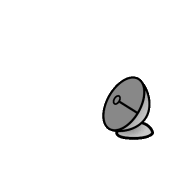
The satellite being in Low Earth Orbit (LEO), at an altitude of about 600 km, the only way for our team to send instruction to it is through the radio communication link. The satellite is controlled remotely from our ground station located in Meudon, France, using dedicated data packets containing instructions for the On-Board Computer to execute. These packets which go from Earth to space (uplink) are called "telecommands". When a telecommand packet is received by the satellite radio receiver, it is retrieved by the computer, unpacked, and executed.
A telecommand packet is an extremely precise instruction to which the computer has been specifically programmed to respond. There is no way for us to send arbitrary commands to the satellite. For example, if we want the satellite to point Beta Pictoris, we have to have programmed a sequence of steps in the computer software to do just that, and which can be triggered upon the reception of a given sequence of bytes (the telecommand packet). If we forgot to add such a sequence in the on-board software, then there is no way for us to get the satellite to point Beta Pictoris, except by reprogramming the computer (luckily we can do that, and hopefully we won't need to).
There is a total of 152 different commands which can be sent to the satellite. These go from the very basic "echo" command (the satellite sends a given message back to Earth), used to test communications, all the way to high-level commands, like "start science", in which the satellite undergoes a serie of several steps needed to start acquiring data.
Well, at least PicSat is not. There are several actions or tasks that the satellite can undertake on its own, but these are very limited. When the satellite receives the instruction to acquire scientific data, it automaticaly points the coordinate of Beta Pictoris, and starts looking for it. When the star is acquired, the satellite switches on the payload, and starts acquiring science data. If, for any reason, the star is lost, the satellite automatically falls back to the initital pointing sequence. And if a critical failure happens anywhere in the satellite bus, anytime during the mission, the satellite goes to a "safe mode", in which all systems excepts power and radio communications are turned off. But apart from that, PicSat must receive step-by-step instructions to perform its activities.
The On-Board Computer of PicSat has also been programmed to accept delayed telecommands. This means that a telecommand packet containing an instruction can be received by the satellite, stored in memory, and executed at a later time. This allows us to schedule activities for a larger period of time (e.g. up to a few days or so).
Anyone. PicSat receives its instructions on 145.910 MHz, which is an amateur frequency. You just need an amateur license, and some equipment, and you can emit on this band. A software like Gpredict, or our simple pass prediction page will tell you when PicSat is above your head, and so when you can start sending packets to it.
Oh! I almost forgot: you need our cryptographic key, because spacebound packets must be authenticated to be accepted by the satellite...